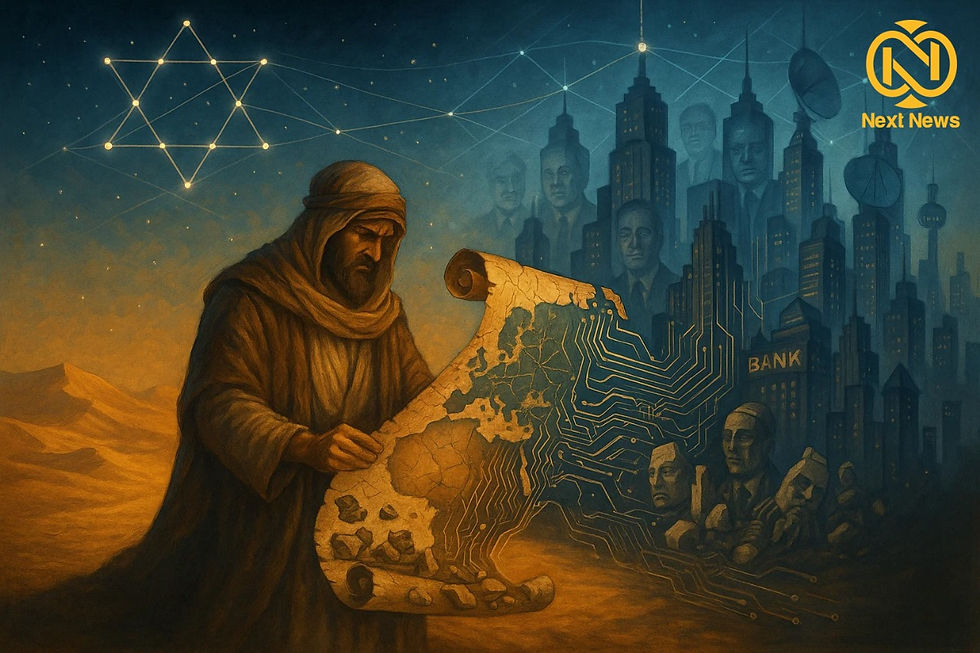The Nomadic Bedouins Who Rule the World
- Fady Philip

- 4 days ago
- 8 min read
Throughout human history, concepts of dominance and hegemony have always been associated with geographic power, civilizational stability, and long-term cultural accumulation. However, there is an anomalous phenomenon in this context that asserts itself strongly: a people who began as nomadic Bedouins, without a fixed land or a homogenous identity, but were then able to transform into one of the most influential peoples in the contemporary global system.

This article does not seek to praise or condemn, but rather to conduct a rational analysis: how does a people who were expelled from every land, rejected by most civilizations, and subjected to massacres and persecution, transform into a soft power capable of transcontinental influence?
How were the Jews, through centuries of diaspora, able to reinvent themselves, create a complex identity, and turn their historical persecution into symbolic capital that is invested in finance, media, and politics?
Perhaps the greatest irony is that the same people who are described in legends as persecuted slaves in ancient Egypt (according to their religious narrative) later transformed into a destructive force against neighboring peoples in Canaan, according to the same account. From a victim of slavery to a practitioner of enslavement, and from a project of extermination in Nazi Europe to a project of displacement and colonization in Palestine. This pivotal transformation is the core of our article, which we will publish in two parts.
What makes the phenomenon even more complex is that the narrative this people relies on to build their historical identity finds no support in archaeology or modern academic documentation—in fact, many of their own historians and scholars deny it.
The renowned Israeli historian "Israel Finkelstein," one of the most prominent contemporary archaeologists, said in the introduction to his joint book with Neil Asher Silberman, "The Bible Unearthed": "The King Solomon described in the Torah as the owner of a flourishing empire, we have not been able to find any architectural or administrative trace that confirms the existence of that kingdom. Perhaps it never existed."
So what does it mean for a nation to build its identity and narrative on myths?
To understand this, we can look at examples from other peoples who built similar narratives to strengthen their national identity, such as the Roman people who wove the story of Romulus and Remus as the mythical foundation of Rome, or the Japanese people who derived the legitimacy of their empire from the lineage of their first emperor to the sun goddess "Amaterasu." The fundamental difference, however, is that these peoples later possessed tangible civilizational tools that reinforced their narrative, whereas in the case of the Jews, the process of identity building relied more on the mythological narrative as an alternative to confirmed material or historical evidence, which makes the analysis of this case both different and noteworthy. The science doesn't support it? And what does it mean to invest these myths to justify the occupation, killing, and displacement of another people in the modern era?
In this article, we will delve into several axes and chapters, including:
How was the Jewish identity formed from fragmented elements stolen from other civilizations?
How did the persecution complex turn into a soft power tool?
How did archaeological narratives fail to confirm the existence of the kingdoms of David and Solomon?
How did the accusation of "anti-Semitism" turn into a global immunity against any political criticism?
This article is not a call for hatred, but an attempt to understand the mechanisms of control from a historical, psychological, and political perspective. Understanding the Jewish case is not just for understanding them, but for understanding how narratives are built and how nations are managed.
Chapter One: From Diaspora to Network
Unlike most peoples who gradually lose their identity in the diaspora, the Jews were able to transform their dispersion into a decentralized international network. This network—which began with closed commercial and communal gatherings—later transformed into transcontinental economic and cultural structures. Instead of being victims of diaspora, they became beneficiaries of it, infiltrating the joints of the economies of Europe, North Africa, and the Middle East.
The advantage of the Jews lay in two things: First, their doctrinal/cultural unity that maintained their cohesion. Second, their position as financial and commercial intermediaries between peoples, which gave them double influence despite their small numbers.
This situation gave them a rare ability to survive and thrive in hostile environments, and they transformed from "strangers" to "influential people" in many European kingdoms, without the need to own land or a state.
1. Diaspora: A Flexible Beginning, Not an End
The Jewish diaspora was not a final fall, but a transformation and a determination to survive through unconventional means. Since their expulsion from their land in ancient times, they swept through Babylon, Persia, and Europe, but what truly made them unique was their ability to form self-governing social entities—such as the "Kahal" in Central Europe, which organized the affairs of the communities despite oppression and persecution.
As evidence that these networks were not only religious but also cultural and educational, the extent of the cohesion of the Jewish communities becomes clear: historians point out that the Jews were "Europeans ahead of their time" thanks to their multiple languages and their movement in European cities.
2. Economics as a Survival Strategy and Political Investment
Their ability to turn shunned activities—such as usury—into a means of influence was central. The Rothschild family, for example, used an international banking network, founded by Mayer Amschel Rothschild through 5 main branches (Frankfurt, London, Paris, Vienna, Naples), which gave them an advantage in the rapid movement of money and information.
During the Napoleonic Wars, Nathan Rothschild provided crucial funding to the British, such as massive financial facilities after 1815. In the nineteenth century, the family funded infrastructure: railways, mines, and even the Suez Canal; an matter that helped them control the European economy.
Niall Ferguson, a historian, described it as: "For most of the nineteenth century, Nathan Rothschild was part of the largest bank in the world that dominated the international bond market… something like a merger of Merrill Lynch, Goldman Sachs, and the International Monetary Fund all at once."
3. From Scattered Diaspora to a Global Network
The Jewish network was not limited to Europe, but extended to North Africa, Turkey, and America. The common language and culture (Yiddish/Ladino), and the transcontinental Jewish communities, provided an unprecedented level of communication and mutual support. A historian like Simon Dubnow proposed the concept of "Diaspora autonomy," a vision that sees the diaspora not as a setback, but as a base for a mobile community capable of self-organization and political expression.
In the age of media and the internet, the diaspora transformed into a soft power equipped with real influence, from international lobbies to supporting Israeli projects.
The diaspora did not destroy identity, but generated it in harsh conditions.
Economics was a means of survival and influence after Jews were banned from agriculture and traditional professions.
The diaspora network is an elective product: built on religion, language, and social solidarity, and supported them in building a global economy and political influence.
Chapter Two: Building an Identity on the Ruins of History
When searching for the origins of Jewish identity, we find that the idea of a "homogenous ethnic people" does not stand up to scientific criticism. The Ashkenazi, Sephardic, Falasha, and others are fundamentally different in race, culture, and language. Nevertheless, a religious/historical narrative was created to unite them under one umbrella.
According to historian Shlomo Sand, in his book "The Invention of the Jewish People," modern Jewish identity was manufactured in the nineteenth century as part of a national project similar to European national projects. There was no Jewish nation in the modern sense, but scattered religious groups that were later merged into a fabricated national entity.
To reinforce this identity, other civilizations were culturally appropriated: such as attributing Canaanite kings and Pharaonic architectural structures to the Israelites, and claiming that the kingdom of David was a civilizational center, while archaeology refutes this.
1. A Fabricated Identity, Not a Fixed One
In the nineteenth century, with the birth of modern nationalisms, we witnessed a tendency to re-author groups into "nations" with connected roots and ethnic origins. Shlomo Sand in his iconic book "The Invention of the Jewish People" explains that Jewish identity—as we see it today—is not a natural continuation throughout history, but a "fabrication" based on false narratives imported from the European West. He points out that this "fabrication" was a response to demographic fragility and social disintegration, not to the true history of the Jewish people.
Sand identifies the destruction of the Second Temple in 70 AD as a turning point, but it did not cause a unification or mass migration as is narrated, but rather created an opportunity for the desire to build a national narrative that compensates for the historical vacuum.
2. Myths Hide Historical Contradictions
The biblical narrative describes a great kingdom under the rule of David and Solomon, but modern excavations show a different reality. According to Israel Finkelstein and Neil Asher Silberman in The Bible Unearthed, archaeological evidence indicates that Jerusalem was a "typical mountain village" and not an imperial capital, and that the united kingdom was authored from the achievements of Omride kings in the ninth century BC.
Others, such as Hoffmeier, describe the "United Monarchy" narrative as being based on myths, while recent discoveries such as the Khirbet Qeiyafa site may support the existence of an administrative structure, but they do not confirm the absolute greatness of a unified Jewish state entity.
3. National Narratives… Not Unique
The main feature in Sand's analysis is the view that national identity is built in the same way as it was built for European peoples: such as the Romans through the myth of Romulus and Remus, or the Japanese through the emperor's descent from the sun goddess. But these peoples eventually had tangible civilizational foundations to support their narratives. Jews, on the other hand, built their identity on mythological narratives, without cohesive archaeological or social support, which makes the case completely unique.
4. Criticism from within Academic Jewish Thought
Even within Israeli academic circles, there are considerable objections to this narrative structure. For example, the book "The Founding Myths of Israel" by the researcher Zeev Sternhell attacks the Zionist national project and describes it as having used myths that link nationalism and socialism, thereby killing any human or pluralistic dimension in the Zionist project.
Contemporary Jewish identity is the product of a modern national project, not a natural historical accumulation.
The founding myths, such as the kingdom of David or a popular connection during the time of the diaspora, are not supported by archaeological evidence.
Jewish nationalism shares the depth of ideological construction with other nations, but without a tangible civilizational narrative, which makes the case completely unique.
In this first part of our journey through history, we did not just trace the steps of a people who wandered from the desert of diaspora, but also the threads of the narratives they wove around themselves in moments of disorientation and persecution. From the stories of exile and enslavement, to attempts to create an independent identity on the ruins of actual history, we saw how the predicament was transformed into a method, and the loss into a tool for survival and repositioning.
But what began as a struggle for survival gradually turned into a project of control and influence, not only by the sword, but by the word, the image, and transcontinental institutions. This is what we will continue to analyze in the second part of the article, when we delve deeper into the real tools that enabled this people to move from the margins to the center of power.









Comments